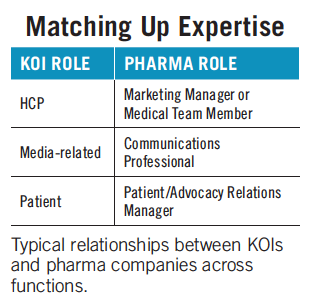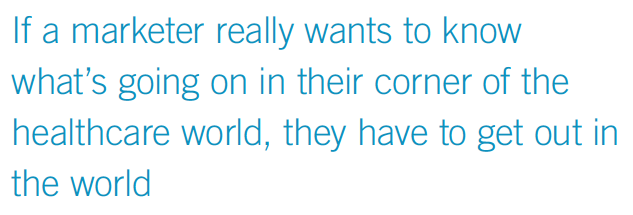How to Harness, Leverage Key Online Influencers
Pharmaceutical Executive
The importance of KOIs in tapping into today’s market mindset.
Throughout most of pharmaceutical marketing history, if you wanted to understand the state of the industry and what direction it appeared to be going, healthcare marketers would rely on the opinions and wisdom of key opinion leaders (KOLs).
The KOL model generally consisted of a few key people at the top of a pyramid-for example, a prestigious doctor at a leading clinic such as your Mayo Clinics or your Memorial Sloan Ketterings. In other words, you would hang on every word from the institutes that had a lot of cache. The intel they had would slowly trickle down the pyramid to the rest of the world. Then somewhere along the way, that model greatly evolved.
It isn’t that key opinion leaders don’t still matter. They very much do, and the KOL shouldn’t be tossed aside. But in today’s reality where we live online just as much as offline, if a pharma marketer only relies on the traditional KOL model to understand the complete mindset of the marketplace, it’s akin to being a doctor attempting to diagnose a patient’s mysterious malady without doing any bloodwork. That stethoscope and tongue depressor may have been useful, but you hardly can say you gave the patient a thorough examination.
If one really wants to understand the temperature and condition of the pharmaceutical industry, they should embrace and include the key online influencer (KOI) model with their KOL efforts.
Who works with KOIs?
The person who typically manages KOIs at pharma organizations depends on where the product/molecule is in its lifecycle. During the pre-launch, a relationship manager on the medical team typically works with KOIs.

During the launch or in-market segment of engagement, KOI relations live across several functions. The KOI’s role sometimes dictates who works with that person or group. The table at right presents a breakdown we often see with clients.
The point is to match the role of the external KOI with a credible subject matter expert internally to improve chances of a successful outcome.
Why you need to understand key online influencers
Again, KOIs are not all that different from KOLs, especially in that there have always been a small percentage of people who spoke to the masses-and their opinions often trickled down (influenced others). Now, marketers’ work with KOIs often replicates what was done with KOLs, but much more quickly.
To understand the importance of the KOI influencer group, it’s critical to first understand an influencer model called the 1-9-90. The reality is that today, online conversation around any given brand is created by roughly 1% of that total audience, while 9% are generally commenting/sharing/liking. Basically, these folks are amplifying their content-bringing it to the 90% who are lurking and learning. This model is an important factor in both social media algorithms and search results alike; so, it becomes a powerful tool once you learn how to leverage it.
The key is to follow who and what matters to your brand. You should know with precision who makes up the people in the 1% and understand the behavior of the 9% so that you can more effectively reach the 90%. Focus on the relevant and influential bits instead of trying to follow and analyze everyone-thus diluting your efforts. In other words, don’t try to “bear hug the beast.”
The KOI’s footprint extends across social media, forums, blogs, and websites. KOIs aren’t just prominent physicians. A KOI may also be a retired doctor with a blog or perhaps somebody who writes a pharmacy blog. They may be allied health professionals, nurses, researchers, caregivers, and super-engaged patients. They may

even be a group of patients, such as the people chiming in on a forum website for people who have bone and joint issues.
Obviously, each brand’s list of KOIs will be different. That list is going to reflect the interests, needs, and wants of a target audience. But the point is-if a marketer really wants to know what’s going on in their corner of the healthcare world, they have to get out in the world. In addition to identifying and getting to know all of your traditional KOLs, it’s now also just as critical to spend time identifying, getting to know, and cultivating relationships with KOIs.
Why you should employ a KOI strategy
One might well wonder why it’s worth spending any time at all with KOIs. Brand teams are already plenty busy, and members may feel as if they’re already plugged in. Isn’t that enough? But it may not be. There are a few reasons marketers would do well to employ a KOI strategy.
That pyramid has been flattened
As mentioned, information used to travel one way-from up above, down to everyone else. But now, data is more democratic. It’s everywhere; and news gets around far faster than it used to. Scientists, pharmaceutical executives, clinical trial directors-they’re on social media, too. These folks frequently post new information on Twitter, Instagram, Facebook, LinkedIn, and other social platforms.
To put a finer point on this, not long ago, you had to attend an American Society of Clinical Oncology (ASCO) conference in person to learn in real time about the latest data and engage with peers. Of course, it’s still a worthwhile trip for many, but today you can follow along online in near real time and engage with hundreds of peers who are simultaneously in the hall and in more than a dozen other countries. This year, people shared well over a thousand tweets leading up to, during, and following #ASCO2019-most of whom were healthcare professionals (HCPs), researchers, companies, advocacy groups, and several patients. By studying this event online, you can quickly see the most active voices, what announcements resonated most, and what the biggest takeaways were.
Another reason the KOI approach is so important is that some of the key opinion leaders happen to be key online influencers. These two worlds of KOLs and KOIs sometimes overlap and connect and converge in a variety of arenas, including publishers of papers; closely tied networks; clinical investigators; geography; and professional and institutional affiliations.
You can see the big picture far better
If marketers are only focusing on the KOLs, they’re going to get a lot of good information; but they won’t have anything close to all of the information. One reason it’s easy to dismiss the idea of getting to know KOIs is because some are viewed as having a “lack of credibility and dubious reputations.” The reality is that due to their reach, speed, and relevance to certain audience segments, even folks who are ill-informed can still inform your thinking when you’re looking for trends and clues about the direction healthcare is heading.
In fact, sometimes it’s helpful to know what the least knowledgeable medical voices are saying. Think of how the anti-vaccine movement has grown in the last 10 or 20 years. Much of the misinformation spread throughout the internet. And while that may sound like a good argument for tossing a KOI strategy out the window, it can be helpful-even vital-to know the misconceptions that are out there. Back when the anti-vaccine propaganda began, it’s probably safe to say that most pharmaceutical industry executives dismissed it as the rantings of a small group of people on the fringe. With time, however, that fringe moved from the margins closer to the middle.
Like them or loathe them, as anyone with the measles can tell you, the anti-vaccine KOIs have made a significant impact. If something similar is on the horizon, wouldn’t you prefer to know about it earlier rather than later? In fact, you would have the ability to get ahead of the curve to counter their distortions and half-truths if engaged with KOIs.
Competitors are following KOI model
Simply put, you’ve got a significant competitive blind spot if you don’t have a comprehensive, robust universe of KOIs with whom you follow and engage. It’s a risk that brand teams need to shore up-possibly by rethinking oles, functions, process, and policies to enable engagement in new and nimble ways that come with the territory in the online space. Because not just one person at a company should be interacting with KOIs. If there’s a marketing team, a clinical team, a patient advocacy team, a communications team, etc., brand leaders need to consider how KOIs could map to their organization to better leverage its relationships with them.
Not having a raft of KOIs at your disposal can and probably will lead to either online market erosion for existing, in-market products, or online invisibility if your products are new entrants. On the flip/positive side, being tuned into the KOI frequency represents an opportunity for market disruption-if it’s done right.
To that end, the strategy employed to leverage a KOI, once found, is critical.
How to work with KOIs
Social listening
First of all, treat KOIs as you would if you were a zoologist on a safari. Stay in the brush and observe. Listen and learn. Study your online influencers before attempting to engage. Closely track what they do. Observe what their networks are like, who they’re interacting with.
Go under the surface and read what the influencers are sharing (and what they are not sharing). Look at who they amplify and who amplifies them. These people are shaping the online marketplace around your brand every day. Their activities, especially when considered collectively, are impacting search results and traffic to websites; and they are driving share of voice around your brand to your target audiences (both professional and patient).
You don’t just want to walk in and engage with blinders on. You’ll instantly lose credibility if it’s clear that you haven’t really been reading an influencer’s work or taking time to understand their perspective. Get up to speed first. Do your homework. Watch, listen, and learn.
Understand, then engage
Once a brand team better understands what makes KOIs tick, it can develop an engagement plan. Online relationships, just like offline relationships, take time and require plenty of nurturing. But once you’ve found and quantified the relevance of influencers who are worth following, you can start weaving them into your routine. Begin by following them via your online channels. When they say things that intersect with your overall goals, amplify their signal, respond and support, and eventually build a bridge to co-create. With time and focus, you can gain their trust, and earn the right to reach out and ask for input on relevant aspects of your

strategy-involving them in not just the output of marketing messages, but in the process of developing them.
Your brand will be far better off for it. You’ll develop better marketing messages that you know will be relevant and that will pull through to the relevant target audiences around your KOIs. Meanwhile, if all goes well, some of these KOIs will spread the word. That allows the brand team to help shape the narrative that tells the product story.
Avoid pitfalls
KOI relations are not about manipulation. They are about honest listening, dialog, and advocacy. To help ensure a successful KOI plan and avoid mistakes, be sure that you and your organization do the following:
- Conduct plenty of research before building engagement to understand each influencer and the trends in the landscape around them (including understanding the dynamics of advocacy relations).
- Take it slow. Don’t rush relationship development. Like any relationship, it takes time. Nurture, don’t force it.
- Make sure to build a listening plan around the full engagement program.
Be sure to not only listen to those who are positively disposed to your brand, also listen to and understand folks who are brand neutral and brand detractors.
Authentic assimilation
KOIs will, in fact, tell your brand story with or without your help, and so all the better to engage so that you have a hand in telling it. In fact, that’s one of the bonuses of this approach. If a brand team fully inhabits their KOIs’ universes, the student will become the master. Members will find that they’ve gone from following key online influencers to becoming ones themselves.
Francesco Lucarelli is executive vice president, managing director of HCB Health’s Bio Pharma division. Colin Foster is chief digital officer, HCB Health.

Is Artificial Intelligence a ‘Product’? Products Liability Implications for AI-Based Products
April 10th 2025As the physical products we use evolve to become increasingly complex, traditional products liability frameworks may not always fit to provide remedies for harm that can result from using novel product types.